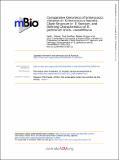Comparative Genomics of Enterococci: Variation in Enterococcus faecalis, Clade Structure in E. faecium, and Defining Characteristics of E. gallinarum and E. casseliflavus
Author(s)
Palmer, Kelli L.; Godfrey, Paul; Griggs, Allison; Kos, Veronica N.; Zucker, Jeremy; Desjardins, Christopher A.; Cerqueira, Gustavo; Gevers, Dirk; Walker, Suzanne; Wortman, Jennifer; Feldgarden, Michael; Haas, Brian J.; Birren, Bruce W.; Gilmore, Michael S.; ... Show more Show less
DownloadPalmer-2012-Comparative genomics.pdf (4.682Mb)
PUBLISHER_POLICY
Publisher Policy
Article is made available in accordance with the publisher's policy and may be subject to US copyright law. Please refer to the publisher's site for terms of use.
Terms of use
Metadata
Show full item recordAbstract
The enterococci are Gram-positive lactic acid bacteria that inhabit the gastrointestinal tracts of diverse hosts. However, Enterococcus faecium and E. faecalis have emerged as leading causes of multidrug-resistant hospital-acquired infections. The mechanism by which a well-adapted commensal evolved into a hospital pathogen is poorly understood. In this study, we examined high-quality draft genome data for evidence of key events in the evolution of the leading causes of enterococcal infections, including E. faecalis, E. faecium, E. casseliflavus, and E. gallinarum. We characterized two clades within what is currently classified as E. faecium and identified traits characteristic of each, including variation in operons for cell wall carbohydrate and putative capsule biosynthesis. We examined the extent of recombination between the two E. faecium clades and identified two strains with mosaic genomes. We determined the underlying genetics for the defining characteristics of the motile enterococci E. casseliflavus and E. gallinarum. Further, we identified species-specific traits that could be used to advance the detection of medically relevant enterococci and their identification to the species level.
IMPORTANCE: The enterococci, in particular, vancomycin-resistant enterococci, have emerged as leading causes of multidrug-resistant hospital-acquired infections. In this study, we examined genome sequence data to define traits with the potential to influence host-microbe interactions and to identify sequences and biochemical functions that could form the basis for the rapid identification of enterococcal species or lineages of importance in clinical and environmental samples.
Date issued
2012-02Journal
mBio
Publisher
American Society for Microbiology
Citation
Palmer, K. L. et al. “Comparative Genomics of Enterococci: Variation in Enterococcus Faecalis, Clade Structure in E. Faecium, and Defining Characteristics of E. Gallinarum and E. Casseliflavus.” mBio 3.1 (2012): e00318–11–e00318–11. © 2012 Palmer et al.
Version: Final published version
ISSN
2150-7511
2150-7511